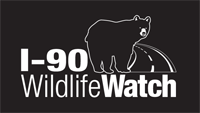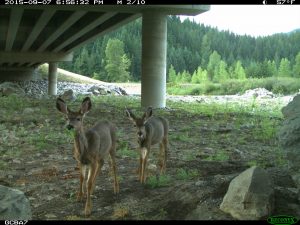 Public and private partners re-launched an updated wildlife-monitoring website aimed at getting feedback from motorists traveling on Interstate 90 over Snoqualmie Pass.
Public and private partners re-launched an updated wildlife-monitoring website aimed at getting feedback from motorists traveling on Interstate 90 over Snoqualmie Pass.
The site, I-90 Wildlife Watch, invites information from the 28,000 motorists that drive over Snoqualmie Pass each day. The data motorists provide will allow public agencies and conservation groups information about the movement of wildlife within the I-90 corridor. The area features newly completed and under-construction wildlife crossings, part of a major highway improvement effort, the I-90 Snoqualmie Pass East Project, by the Washington State Department of Transportation (WSDOT).
“We are proud to re-launch this website to expand opportunities for locals, visitors and other motorists to engage directly with wildlife conservation, monitoring, and education in the Snoqualmie Pass region,” said Jen Watkins, lead project coordinator for I-90 Wildlife Watch and Conservation Associate with Conservation Northwest.

Two deer in the Gold Creek underpass within the I-90 Snoqualmie Pass East Project. Photo credit: WSDOT
“We are now both hearing from motorists on what they see from Interstate 90, and giving them a glimpse of how fish and wildlife are responding to the historic private and public conservation investments in this landscape, most notably new animal crossings under and over the interstate,” said Watkins.
Interstate 90 crosses the Cascades at Snoqualmie Pass, where traffic volumes average 28,000 vehicles per day and are increasing by approximately 2 percent per year. While I-90 is a vital east-west transportation corridor in the state, it also bisects a critical north-south wildlife corridor for wildlife moving throughout the Cascade Mountains and from the Alpine Lakes Wilderness and Mount Rainier National Park.
As part of the I-90 improvement project, WSDOT plans to build 24 wildlife crossing structures between Hyak and Easton to provide a safe roadway for both motorists and wildlife.
These structures range in size from enlarged culverts passing under the interstate to 150-foot vegetated bridges over the roadway. Construction on these crossings are underway. WSDOT has already completed two undercrossings near Hyak and is in the process of building the Keechelus Lake Wildlife Overcrossing, scheduled to be complete in 2019, over the roadway near Price Creek.
The wildlife crossing projects were long championed for inclusion in WSDOT’s project by local conservation, recreation and business organizations as a win-win for animals, motorists and the freight industry, including by the I-90 Wildlife Bridges Coalition and Conservation Northwest’s I-90 Wildlife Corridor Campaign.
“Each new phase of the I-90 Snoqualmie Pass East Project brings us closer to our goal of minimizing the impact of the highway on the landscape. The project would not be possible without the support of the public and our partners,” stated Mark Norman, WSDOT biologist. The website provides a great opportunity to make connections with those groups. Together we will make I-90 safer for wildlife and motorists for generations to come.”
Originally launched in November 2010, the I-90 Wildlife Watch website began sharing results of wildlife monitoring throughout the I-90 corridor. These results included successful, safe passage of wildlife, from families of ducks to herds of deer, through the completed wildlife undercrossings.
Continued information reported by motorists through the website will complement the ongoing research to help agencies better understand which species are interacting with the highway today and into the future.
“I-90 Wildlife Watch is a wonderful opportunity to foster participation, education, innovation, and collaboration in wildlife research,” remarked Patty Garvey-Darda, wildlife biologist with the Okanogan-Wenatchee National Forest. “Through the I-90 Wildlife Watch, the public, local agencies and universities can work together to learn how to restore the connectivity of wildlife populations in the National Forest and protect public safety through the prevention of vehicle and animal collisions.”
I-90 Wildlife Watch is a collaborative effort led by Conservation Northwest, a non-profit regional wildlife and wildlands organization, Central Washington University, WSDOT, the Washington Department of Fish and Wildlife, the U.S. Fish and Wildlife Service, and the U.S. Forest Service.
I-90 Wildlife Watch asks motorists to pay careful attention as they travel I-90 between North Bend and Easton and to report observations of live or dead wildlife at www.i90wildlifewatch.org. The website also provides images and blogs from research of wildlife in the Snoqualmie Pass region, including animals using the new crossings!